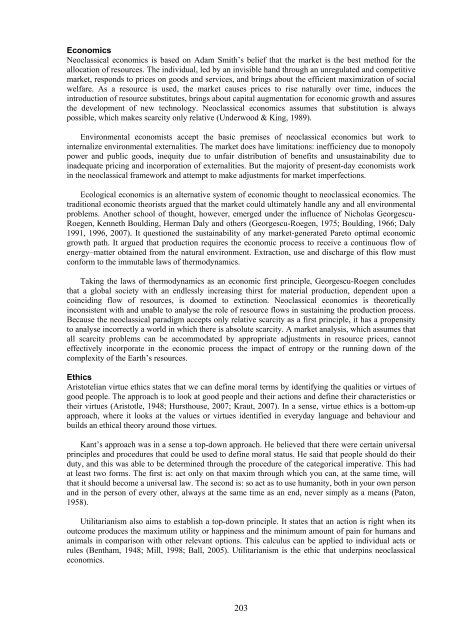traditional knowledge conference 2008 te tatau pounamu
traditional knowledge conference 2008 te tatau pounamu
traditional knowledge conference 2008 te tatau pounamu
You also want an ePaper? Increase the reach of your titles
YUMPU automatically turns print PDFs into web optimized ePapers that Google loves.
EconomicsNeoclassical economics is based on Adam Smith’s belief that the market is the best method for theallocation of resources. The individual, led by an invisible hand through an unregula<strong>te</strong>d and competitivemarket, responds to prices on goods and services, and brings about the efficient maximization of socialwelfare. As a resource is used, the market causes prices to rise naturally over time, induces theintroduction of resource substitu<strong>te</strong>s, brings about capital augmentation for economic growth and assuresthe development of new <strong>te</strong>chnology. Neoclassical economics assumes that substitution is alwayspossible, which makes scarcity only relative (Underwood & King, 1989).Environmental economists accept the basic premises of neoclassical economics but work toin<strong>te</strong>rnalize environmental ex<strong>te</strong>rnalities. The market does have limitations: inefficiency due to monopolypower and public goods, inequity due to unfair distribution of benefits and unsustainability due toinadequa<strong>te</strong> pricing and incorporation of ex<strong>te</strong>rnalities. But the majority of present-day economists workin the neoclassical framework and at<strong>te</strong>mpt to make adjustments for market imperfections.Ecological economics is an al<strong>te</strong>rnative sys<strong>te</strong>m of economic thought to neoclassical economics. The<strong>traditional</strong> economic theorists argued that the market could ultima<strong>te</strong>ly handle any and all environmentalproblems. Another school of thought, however, emerged under the influence of Nicholas Georgescu-Roegen, Kenneth Boulding, Herman Daly and others (Georgescu-Roegen, 1975; Boulding, 1966; Daly1991, 1996, 2007). It questioned the sustainability of any market-genera<strong>te</strong>d Pareto optimal economicgrowth path. It argued that production requires the economic process to receive a continuous flow ofenergy–mat<strong>te</strong>r obtained from the natural environment. Extraction, use and discharge of this flow mustconform to the immutable laws of thermodynamics.Taking the laws of thermodynamics as an economic first principle, Georgescu-Roegen concludesthat a global society with an endlessly increasing thirst for ma<strong>te</strong>rial production, dependent upon acoinciding flow of resources, is doomed to extinction. Neoclassical economics is theoreticallyinconsis<strong>te</strong>nt with and unable to analyse the role of resource flows in sustaining the production process.Because the neoclassical paradigm accepts only relative scarcity as a first principle, it has a propensityto analyse incorrectly a world in which there is absolu<strong>te</strong> scarcity. A market analysis, which assumes thatall scarcity problems can be accommoda<strong>te</strong>d by appropria<strong>te</strong> adjustments in resource prices, canno<strong>te</strong>ffectively incorpora<strong>te</strong> in the economic process the impact of entropy or the running down of thecomplexity of the Earth’s resources.EthicsAristo<strong>te</strong>lian virtue ethics sta<strong>te</strong>s that we can define moral <strong>te</strong>rms by identifying the qualities or virtues ofgood people. The approach is to look at good people and their actions and define their charac<strong>te</strong>ristics ortheir virtues (Aristotle, 1948; Hursthouse, 2007; Kraut, 2007). In a sense, virtue ethics is a bottom-upapproach, where it looks at the values or virtues identified in everyday language and behaviour andbuilds an ethical theory around those virtues.Kant’s approach was in a sense a top-down approach. He believed that there were certain universalprinciples and procedures that could be used to define moral status. He said that people should do theirduty, and this was able to be de<strong>te</strong>rmined through the procedure of the ca<strong>te</strong>gorical imperative. This hadat least two forms. The first is: act only on that maxim through which you can, at the same time, willthat it should become a universal law. The second is: so act as to use humanity, both in your own personand in the person of every other, always at the same time as an end, never simply as a means (Paton,1958).Utilitarianism also aims to establish a top-down principle. It sta<strong>te</strong>s that an action is right when itsoutcome produces the maximum utility or happiness and the minimum amount of pain for humans andanimals in comparison with other relevant options. This calculus can be applied to individual acts orrules (Bentham, 1948; Mill, 1998; Ball, 2005). Utilitarianism is the ethic that underpins neoclassicaleconomics.203
















